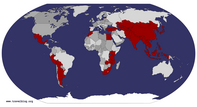Turkey 2004
May 4th 2004 -» December 27th 2004
Southern Africa 2005
January 14th 2005 -» November 2nd 2005
Indochina 2006
January 28th 2006 -» November 16th 2006
The Philippines 2007
March 1st 2007 -» December 15th 2007
Mexico 2008
January 14th 2008 -» August 1st 2008
East Africa 2009
August 11th 2009 -» December 29th 2009
China & Myanmar 2011
June 1st 2011 -» December 11th 2011
Egypt 2012
January 22nd 2012 -» April 8th 2012
Nepal India Borneo 2012 - 2013
September 12th 2012 -» July 23rd 2013
Peru and Bolivia 2014
January 9th 2014 -» November 20th 2014
Portugal 2017
March 7th 2017 -» May 8th 2017
Lithuania, Latvia & Estonia 2017
May 31st 2017 -» June 28th 2017







